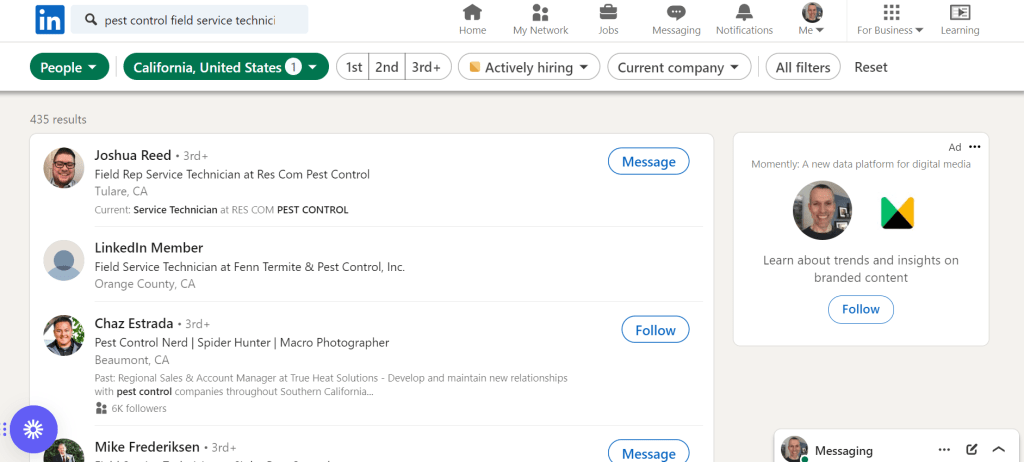Pest Control Hiring: Tips for hiring your first team members
GorillaDesk Staff

At the end of the day, a company is only as good as its people. Creating a team of hard-working individuals to power your pest control business is a huge step on the path to growth.
The right crew keeps your service delivery excellent while also creating loyal customers who become true brand champions. It’s the difference between an Orkin and a fly-by-nite, a 5-star Yelp review score, and a “Don’t use those guys, they sprayed permethrin in my kid’s cornflakes.”
If you’re ready to grow, knowing how to assemble your dream team is crucial to sustained success.
However, pest control is a technical field that requires a specific set of skills and certifications. It has its own standards that are important to uphold, especially when it comes to hiring. Finding the right candidates for your all-star team can feel tricky if you haven’t put some thought and processes in place first.
We created this guide to help you begin to build your all-star team. We’ll dive into the essentials of building your first team, from defining roles and landing the perfect recruits to fostering a positive and productive team culture. All with the goal of creating a sturdy foundation for your business’s future.
1. Define your team’s structure
“Hey, we’ve got to fire this new field service tech — he’s a terrible fit.” You don’t want to go through all the work of hiring, only to find out after the first few weeks that you’ve completely botched it. Hiring success starts with getting the basics down first. And the basics will make hiring future employees an easier, repeatable process in the months and years to come.
Identify key roles
Start by identifying the key roles that will form the backbone of your operations. A fully staffed pest control team usually includes several positions:
- Technicians: The frontline workers who handle the pest control tasks. Technicians should be knowledgeable about specific pest management techniques and comfortable with the tools and products your company uses in the field.
- Customer service representatives or admin: These team members manage client interactions, schedule appointments, and handle follow-ups. Their role is crucial in keeping customers happy and business running smoothly.
- Sales personnel: They’re responsible for generating new business by engaging potential customers, explaining your services, and getting them to schedule a service. They need a deep understanding of customer pain points and a massive sense of empathy.
Depending on the size of your business and the range of services you offer, you might also need roles like a field supervisor, operations manager, or marketing specialist. If you’re a small business, you might start with just one or two technicians and a person who handles both sales and customer service. And as your client base grows, your team will too.
Define the role requirements
Before you can start hiring (or even writing job descriptions), you need to take a little time to define your role requirements.
Don’t worry — this doesn’t need to take all day. If you’re a small shop and you’re a field tech hiring another you, this part is easy. If not, sit down and write up the skills and personal qualities each role requires. If you’re not sure, have a chat with others on your team — or with leaders at similar companies on LinkedIn.
Define the role in terms of skills, personality traits, job duties, and what success looks like in the position. Starting with the nitty gritty will make it a lot easier to plow through the next steps in your hiring process.
2. Create detailed job descriptions
Have you ever seen a really good promotion, maybe at a local restaurant, and it seemed too good to be true? But you showed up to claim the deal anyway, only to discover it wasn’t as good as you thought. There was some fine print you didn’t read, or they worded the offer funny.
It’s happened to the best of us, and it’s frustrating.
Unclear or misleading job descriptions can have much the same impact — generating plenty of candidates — but not the right ones — and making your job of finding a qualified employee even harder.
Trust us, you don’t want to learn the hard way how important clear, detailed job descriptions are.
A well-written job description should outline the duties and expectations associated with the role as well as the qualifications and skills required. Make sure to:
- List essential responsibilities: Clearly state the daily tasks and responsibilities of the role. This helps candidates understand what will be expected of them.
- Specify qualifications: Include necessary certifications, educational levels, and specific skills (like familiarity with certain types of pest control products or techniques).
- Describe the work environment: Note whether the job will involve outdoor work, require heavy lifting, or entail long hours. Being clear about these details can prevent misunderstandings later.
Don’t worry, we aren’t going to leave you hanging. Take a look at our sample job descriptions to help you get the ball rolling. You can copy, paste, and edit these descriptions to use in your hiring process.
Sample pest control technician job description
Job Summary: The technician will provide pest control services to residential and commercial clients in the Alameda area using a variety of tools and techniques. Must be able to assess pest problems, apply treatments, and suggest preventive measures.
Duties:
- Inspect properties for signs of pests.
- Determine the best course of treatment.
- Safely apply chemical or natural treatments.
- Provide clients with support and advice on preventing future issues.
Qualifications:
- High school diploma or equivalent; certification in pest control is a plus.
- Driver’s license in good standing.
- Strong problem-solving and customer service skills.
- Ability to handle physical work and lift up to 50 lbs.
Sample customer service representative job description
Job Summary: As a key point of contact for our clients, the customer service representative will manage appointments, respond to inquiries, and provide outstanding customer service to current clients. We put our clients first, so good people skills are a must.
Duties:
- Answer phone calls and respond to emails from clients.
- Schedule service appointments and coordinate with technicians.
- Follow up with clients post-service to gather feedback and help resolve any concerns.
Qualifications:
- High school diploma or equivalent.
- Previous experience in customer service preferred.
- Excellent communication and organizational skills.
- Proficiency in using computer software like QuickBooks and CRM systems.
With clearly defined roles and detailed job descriptions, you can make the recruitment process more targeted and less cumbersome. You’ll attract candidates who are not only capable but also a good fit for your team’s culture and your business goals.
3. Find your first team members
It’s time to get the word out about your new job openings. Here’s how to reach your target candidates and begin the screening process.
Use multiple hiring channels
To cast your net effectively, use multiple channels to advertise your job openings. Each channel might attract a different type of candidate, giving you more diverse options. Cover all the bases with:
- LinkedIn: By far the best place to find your next A-player is on LinkedIn. Over a billion employers and job seekers interact there for a reason! That reason is its super easy interface that lets you define your ideal candidate, then search. You can also post jobs there, and/or use AI recruiting software to efficiently identify the most relevant applicants.
- Online job boards: Platforms like Indeed, Monster, and LinkedIn are great for reaching a broad audience. Industry-specific sites like PestWeb or the National Pest Management Association’s jobs hub may be worth a try too.
- Industry conferences and vocational schools: Engaging with professionals and upcoming graduates at these events can help you tap into a pool of candidates who are already interested in pest management as a career.
Local community networks: Post job openings on online community boards and in relevant social media groups on Facebook or LinkedIn. Sometimes the best candidates are locals who are looking for opportunities right in their neighborhood.How to use LinkedIn to find pest control employees
You can find pest control job candidates by searching for the job title you’re hiring for on LinkedIn, such as “pest control field service technician.” Then click the “People” button at the top left, and set your location with the button next to that.
Pro Tip: Your next unicorn employee might not call herself a “field service technician” or a “pest control specialist. Use ChatGPT to build a list of similar job titles to search for on LinkedIn.
For more advanced hiring muscle on LinkedIn, sign up for a free trial of their Recruiter Lite tool. It lets you send 30 inMail messages a month, and use 20+ search filters to dial in your search. After the free trial, it costs $240 a year.
You can also post a job on LinkedIn by clicking the briefcase icon on the top of your LinkedIn page.
But reaching the right candidates isn’t the only thing to think about. You also need to appeal to them. How do you show off your company culture and team? Social media can be a great tool here, allowing you to share posts about your business in a more informal setting. Posting behind-the-scenes photos of your team at work, customer testimonials, and employee spotlights can help attract like-minded workers.
4. Screen your candidates
You can’t afford to let even one bad employee into your company. A single bad hire can cost your company $17000 or more, not to mention the angry customers, damaged reputation, and new gray hairs.
So, once you start receiving applications, the real work begins — screening your candidates to find the best fit. Being diligent at this stage will help you maintain high standards to build a truly all-star team.
- Background checks: Always conduct background checks to avoid legal issues that could impact your business. Services like Checkr or Sterling are popular with small businesses. A background check costs $50 to $80 per candidate, but it can save you from a lawsuit later. Also, don’t forget to include an OIG background check to ensure the applicant isn’t on the Office of Inspector General’s exclusion list. Hiring someone on this list can lead to hefty penalties and non-compliance issues.
- Reference checks: Speaking to previous employers can provide insights into a candidate’s work ethic and personality. Ask specific questions to get the information you need. The best question? “Would you hire this employee again?”
Skill assessments: Practical tests, like identifying types of pests or demonstrating safe chemical handling, can help you assess technical skills firsthand. Preemploymentassessments.com offers custom testing for new job candidates. Interview your candidates
Remember that interviews aren’t just about assessing skills but also about understanding if a candidate fits your company culture. The best technical skill set in the world is nothing to brag about if your new hire rubs everyone the wrong way. Here are a few tips for conducting effective interviews:
- Prepare in advance: Develop a list of questions that align with your company’s values and the specific job duties.
- Use behavioral interview techniques: Ask candidates to describe past experiences where they demonstrated problem-solving, customer service, or teamwork skills.
- Be transparent: Discuss the challenges and rewards of the job frankly. This approach helps set realistic expectations and filters out people who might not be a good fit.
If you’re ready to hire a pest control technician, we’ve created some sample interview questions to get you started.
Sample interview questions for a pest control technician candidate
The interview is your best time to assess your next pest control superstar. Asking the right questions will give you a revealing look behind the walls. Does your next PMP, customer service, or sales pro have what it takes to take your business to the next level?
Technical expertise and experience
- Can you walk me through your experience with pest control techniques and what types of pests you’ve dealt with in the past?
- Describe the steps you would take to treat a typical rodent problem in a residential home.
- What safety measures do you consider essential when applying pesticides indoors and outdoors?
- Have you ever faced a pest infestation that you couldn’t resolve on your first try? What steps did you take to eventually manage it?
Customer service and communication
- Explain how you would handle a situation where a customer was unhappy with the services provided.
- Describe a time when you had to explain technical information about a pest control treatment to a client who was not familiar with the process.
- How do you ensure customer satisfaction while adhering to the technical requirements of pest control?
Problem-solving and adaptability
- Tell me about a challenging pest control problem you encountered and how you solved it.
- Have you ever had to change your pest management strategy midway through a job? What prompted the change and what was the outcome?
Teamwork and collaboration
- Describe a time when you had to work closely with a team to complete a pest control project. What role did you play in ensuring the team’s success?
- How do you handle conflicts with coworkers, especially in stressful situations like a large-scale infestation cleanup?
Ethical and safety considerations
- How do you stay updated with the latest pest control laws and safety regulations?
- Describe a situation where you had to make a decision that involved ethical considerations, like using chemicals in sensitive areas (schools, hospitals, etc.).
Motivation and work ethic
- What motivates you to work in the pest control industry?
- How do you manage your tasks during a particularly busy season?
Scenario-based question
- Imagine you’re scheduled to handle three homes in one day, but you discover a major infestation at the first home that requires immediate and extensive treatment. How would you handle the situation with the clients at the other two homes?
For a more comprehensive list of questions specifically for pest control technicians, see our article: 27 pest control interview questions & answers
5. Ensure compliance and safety
As you assemble your pest control employee lineup, you want to find individuals who are ready to tackle the challenges of the job. But you don’t want a smooth, fast hiring process that ends up in a $120,000 workers’ comp claim. So — you need to ensure that everyone on your team operates safely and in compliance with the law. This foundation protects your clients and team members and shields your business from potential legal issues.
Train for safety and compliance
Before your new hires make their first service call, make sure they’re well-versed in the following key safety areas:
- Handling chemicals: Educate your team members on the correct and safe handling of pesticides, including the use of personal protective equipment (PPE), safe storage practices, and emergency procedures in case of accidental exposure.
- Equipment use: Training should cover the proper operation and maintenance of sprayers, bait guns, and other pest control equipment to prevent accidents and ensure effective application.
- Environmental protection: Teach your team how to minimize environmental impact while using pesticides and other chemicals. This is crucial for compliance with federal and state regulations.
What to include in a safety training session:
- Demonstrations on applying pesticides safely
- A review of the Material Safety Data Sheets (MSDS) for chemicals used
- Overview of key local and state pest control laws
Quizzes to make sure employees comprehend the safety protocols
Compliance guidelines
Depending on the type of pest control you offer and your municipality and state, the specific compliance standards for your business will vary. Some common compliance issues to have on your radar are:
- Licensing requirements: Depending on your location, your business and staff may need specific licenses to legally perform pest control services. Most states require a pest control business license, along with individual certifications for technicians, which usually involves passing a professional exam. See our guides for obtaining pest control licenses in Florida, Arizona, Texas, and California.
- Environmental regulations: Familiarize yourself with the Environmental Protection Agency (EPA) guidelines and local laws affecting pesticide use. Staying informed will help you avoid violations that could lead to fines or worse.
Create a compliance checklist
To keep your business on the right side of the law, maintaining a compliance checklist with your staff is indispensable. Here’s a basic checklist to get you started:
- Verify licensing: Ensure all employees have the necessary individual licenses to perform pest control tasks in your state. Regularly check that these credentials are up to date.
- Document training: Keep detailed records of all training sessions, including topics covered and attendance. These records can be critical in case of legal issues or audits.
- Review safety protocols: Regularly update and review your safety protocols with your team to incorporate the latest safety standards and regulatory changes.
- Conduct regular audits: Schedule periodic audits to ensure all practices are compliant with health, safety, and environmental regulations. Consider hiring an external consultant to perform these audits for an unbiased review.
- Stay updated on changes: Keep abreast of new laws and regulations by subscribing to industry publications, attending conferences, and participating in training offered by regulatory bodies.
- Implement environmental safeguards: Establish procedures for handling and disposing of pesticides that comply with local environmental protection laws.
In pest control, compliance isn’t just a legal requirement; it can be a competitive advantage that sets your business apart in the market.
6. Build a supportive culture
“I have such a great team. Everyone pulls their weight, and they all go above and beyond. They’re just a joy to work with.”
Kind of makes your mouth water, doesn’t it?
Establishing a workplace culture that promotes teamwork, learning, and respect makes your business a place where people want to work and build their careers. Here’s how to lay a solid foundation.
Foster a supportive work environment
Creating a culture of teamwork and learning starts with leadership. The behaviors you model and the practices you implement will set the tone for the rest of the company. Start your team off in harmony with:
- Team-building activities: Regular team-building events can improve collaboration and morale. Look for activities that are both fun and relevant to your industry, like problem-solving challenges that mimic difficult pest control scenarios or team outings to relevant workshops or seminars. Pest Control Technology publishes a list of upcoming industry events, and you can find webinars on LinkedIn.
- Continuous learning: Encourage continuous professional development by offering access to ongoing training programs, educational apps, workshops, and courses relevant to the pest control industry. This not only keeps your team up-to-date with the latest techniques but also shows that you value their growth. You can find dozens of continuing ed classes online at relatively low cost.
- Regular meetings: Hold regular strategy meetings — not just to plan and address business needs, but to solicit feedback and ideas from your team. This inclusion fosters a sense of belonging and mutual respect among all members.
Come up with company events that embody your culture and that employees can rally around. For example, you could hold a quarterly Innovation Day where team members present ideas for improving services or operations. This can help keep morale high and also keep your business competitive. But these events can backfire unless you’re ready to support your team with time and other resources to put approved ideas into action. To do it right, see these nine tips to create a lean idea system.
To foster mutual respect among team members:
- Maintain open communication channels: Make sure employees have a direct line of communication to you and encourage them to voice their concerns and suggestions without fear of dismissal. This approach helps to resolve potential conflicts openly and quickly.
- Honor diversity and inclusion: Create policies that enhance diversity and inclusion in your workplace. Embracing different cultures and perspectives can enrich your team’s dynamics and improve service delivery through a deeper understanding of different client backgrounds.
7. Cultivate loyal employees
Imagine you just hired the most amazing employee you’ve ever met. They show up early, work late, all your team members love them, and your customers tell their friends about them. But then — disaster! They quit two weeks later and move on to greener pastures.
Keeping employees around starts with investing in their growth for the long term. Workers want to feel like you’re supporting their career for today and tomorrow. After the hire, consider implementing:
- Career ladder: Create clear career paths for all roles, then communicate these paths during the hiring process and in performance evaluations. Employees are more likely to stay if they see a future for themselves in your company. A field service tech is a field service tech, but you can create a Level I, Level II, and Level III designation with different pay grades. You could also set up different 401k match levels depending on seniority.
- Fair compensation: Make sure your compensation packages are competitive in the pest control industry. Check average pay rates in your area on ZipRecruiter or similar platforms. Offer benefits like health insurance, paid leave, and bonuses based on performance.
- Recognition programs: Implement recognition programs that highlight employee achievements. You could offer through monthly awards, public acknowledgments, or features in company communications. For extra impact, consider ordering custom employee recognition awards online that can be personalized with names, certifications, and safety milestones.
- Regular feedback: Provide constructive feedback regularly, not just during annual reviews. Have a two-way conversation where employees can discuss their experiences and aspirations. Consider holding regular one-on-one meetings with team members to check in and discuss how things are going in their role.
- Mentorship programs: As your company grows, think about establishing mentorship programs where less experienced employees can learn from seasoned professionals. These programs help newer employees grow while also building a sense of responsibility and pride in mentors.
- Annual retreats: Hosting an annual retreat focused on training and team bonding can make employees feel appreciated. This event can double as a celebration of the past year’s successes and a brainstorming session for the year ahead, contributing to higher team cohesion and employee retention.
By creating a work environment that draws talented individuals to your company and encourages them to stay and grow with you, you’re Investing in the future of your business.
Build your pest control dream team
Your employees are the difference between a clean, tight business and one that’s ripping at the seams. Assembling an all-star team for your pest control company starts with laying a strong foundation. Clearly define your roles, recruit strategically, and provide comprehensive training. After the hire, put systems in place to make sure your business is a comfortable and engaging place to work. By setting clear expectations and offering the necessary tools and support, you’re paving the way for a dedicated and efficient workforce that gets the job done fast, follows safety and compliance rules, and generates a stream of happy customers. Now get out there and build your pest control all-star team!
Other posts to check out
Make the move from paper to digital: A step-by-step guide for field service pros
If your field service business is still doing business on paper, it’s time to make a change. Here’s how to find success with a move to digital.
Pest control marketing: Let’s make that phone ring
With so many other local pest control companies making competition tight, keeping that phone ringing with new customers may not feel as easy as you thought. To keep your pest control business growing takes marketing know-how. Here are our best tips.
How to get more positive customer feedback
Customers trust online reviews just as much as word of mouth from friends and family. The truth is: Online reviews can make or break your local services business. Here’s how to build that glowing reputation your service deserves.
Tree service marketing: 11+ ideas to drive more customers in 2025
Drive more leads with our ultimate tree service marketing guide! Discover 11+ proven strategies to grow your business and attract the right customers.
How to start a tree service business in 2025
Learn how to start a tree service business with step-by-step guidance on planning, licensing, equipment, marketing, safety, and scaling your company.
Landscaping services list: What to offer your customers
Discover the top landscaping services to offer for maximum profit. From design to maintenance, expand your business with our comprehensive landscaping services list.
Transform your business
Try it free for 14 days. No credit card required. Instant setup.
★★★★★
We will be customers for life
“I can not say enough good things about GorillaDesk it saves us so much time and money. The customer service is the best. I would recommend GorillaDesk to anyone no matter what industry. I trained my employee in 5 minutes on how to use it. We will be customers for life.”

Ryan Sullivan
Business Owner
Ready to Get Started?
Get all our amazing features and top-rated support, with no credit card required.









